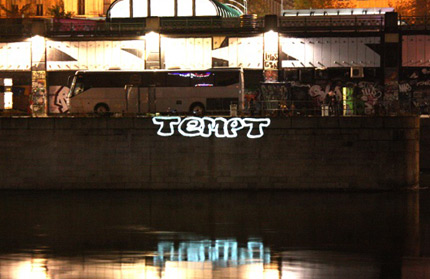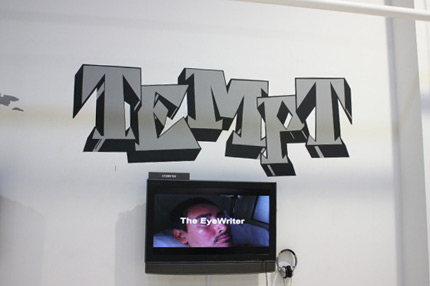
Graffiti produced through the EyeWriter system is projected onto a Viennese riverbank while its creator lies bedridden with ALS thousands of miles away. Photos from EyeWriter website
“Tempt” is a graffiti tag revered throughout Los Angeles’s fertile street-art scene. At once compact and loping, angular yet bulbous, it has overshadowed the work of aerosol arrivistes tagging Downtown LA’s warehouses, Metro cars and garages for over 25 years. Despite its stylistic merits, "Tempt" wouldn’t be so resistant to passing street-art fashions if not for two crucial factors: a remarkably dedicated fan base and its creator’s determination — against crippling obstacles — to continue his art.
Tony Quan, aka Tempt One, is bed-ridden with amyotrophic lateral sclerosis, commonly known as ALS or Lou Gehrig’s disease. He has no use of his arms or legs, cannot speak and breathes with respirator assistance. His mind, however, still burns with an artist’s intractable desire for expression, and like many people with ALS, he retains significant muscle control over his eyes.
Eye-tracking systems have allowed ALS sufferers such as Stephen Hawking to communicate via recorded voice, and were commercially available prior to Quan’s 2003 diagnosis. Illustration programs intended for street artists, however, were certainly not. Quan’s condition led to the development of the EyeWriter: a system that allows him to compose graffiti tags on a monitor screen, purely by moving his eyes.

Tony Quan, aka Tempt One, is bed-ridden with amyotrophic lateral sclerosis, commonly known as ALS or Lou Gehrig’s disease. He has no use of his arms or legs, cannot speak and breathes with respirator assistance. His mind, however, still burns with an artist’s intractable desire for expression, and like many people with ALS, he retains significant muscle control over his eyes.
Eye-tracking systems have allowed ALS sufferers such as Stephen Hawking to communicate via recorded voice, and were commercially available prior to Quan’s 2003 diagnosis. Illustration programs intended for street artists, however, were certainly not. Quan’s condition led to the development of the EyeWriter: a system that allows him to compose graffiti tags on a monitor screen, purely by moving his eyes.

Tony Quan (shown on monitor) and one of his "Tempt" tags.
The EyeWriter was spearheaded by the Graffiti Research Lab — a sort of decentralized think tank for artists, pranksters and protestors that stages multimedia interventions around the world. Its founding members, who are either professors at or graduates of Parsons the New School for Design, started by mounting a small camera onto chunky eyeglass frames. Facing Quan’s right eye, the camera captures his pupil inputs as it passes over a palette of colors and effects. He “clicks” by pausing his gaze for four seconds over the desired tool. When a design is complete, Quan does not save it with a JPEG or GIF file extension, but as GML: Graffiti Markup Language, a specialized format developed by the EyeWriter team. He then uploads his work to a server for open viewing. Tempt One acolytes, using nothing more sophisticated than an a/v cable, a digital projector and wifi, have thrown “Tempt” tags onto Kyoto’s city hall, Vienna’s riverbanks and Los Angeles’s hi-rises — all while Quan remained in bed, both eyewitness and perpetrator.
Zach Lieberman, one of the EyeWriter’s developers, is slated to teach a spring 2010 course at Parsons that will challenge students to push this technology forward. “We wrote the software on top of openFrameworks, a cross-platform, open-source C++ library for artists and hackers that we’re actively developing,” Lieberman explains. The democratic nature of the experiment is further evidenced on the EyeWriter website, where how-to videos and source code are freely available for developers eager to tinker. Its open-source fundamentals also keep development costs astonishingly low. Free software mates with $50 eyewear-camera apparatus, requiring the artist only to provide the commercial eye tracker and a PC.
“Tony’s skill and perseverance using the EyeWriter is quite high,” Lieberman says. “He spends a great deal of time perfecting each tag.” This shouldn’t surprise. Tagging has always meant more than spraying Krylon on a building. It means standing up and being counted. As Quan uploads a freshly minted "Tempt" tag from his bed, that significance gets magnified beyond the range of any spray can.
The EyeWriter was spearheaded by the Graffiti Research Lab — a sort of decentralized think tank for artists, pranksters and protestors that stages multimedia interventions around the world. Its founding members, who are either professors at or graduates of Parsons the New School for Design, started by mounting a small camera onto chunky eyeglass frames. Facing Quan’s right eye, the camera captures his pupil inputs as it passes over a palette of colors and effects. He “clicks” by pausing his gaze for four seconds over the desired tool. When a design is complete, Quan does not save it with a JPEG or GIF file extension, but as GML: Graffiti Markup Language, a specialized format developed by the EyeWriter team. He then uploads his work to a server for open viewing. Tempt One acolytes, using nothing more sophisticated than an a/v cable, a digital projector and wifi, have thrown “Tempt” tags onto Kyoto’s city hall, Vienna’s riverbanks and Los Angeles’s hi-rises — all while Quan remained in bed, both eyewitness and perpetrator.
Zach Lieberman, one of the EyeWriter’s developers, is slated to teach a spring 2010 course at Parsons that will challenge students to push this technology forward. “We wrote the software on top of openFrameworks, a cross-platform, open-source C++ library for artists and hackers that we’re actively developing,” Lieberman explains. The democratic nature of the experiment is further evidenced on the EyeWriter website, where how-to videos and source code are freely available for developers eager to tinker. Its open-source fundamentals also keep development costs astonishingly low. Free software mates with $50 eyewear-camera apparatus, requiring the artist only to provide the commercial eye tracker and a PC.
“Tony’s skill and perseverance using the EyeWriter is quite high,” Lieberman says. “He spends a great deal of time perfecting each tag.” This shouldn’t surprise. Tagging has always meant more than spraying Krylon on a building. It means standing up and being counted. As Quan uploads a freshly minted "Tempt" tag from his bed, that significance gets magnified beyond the range of any spray can.
